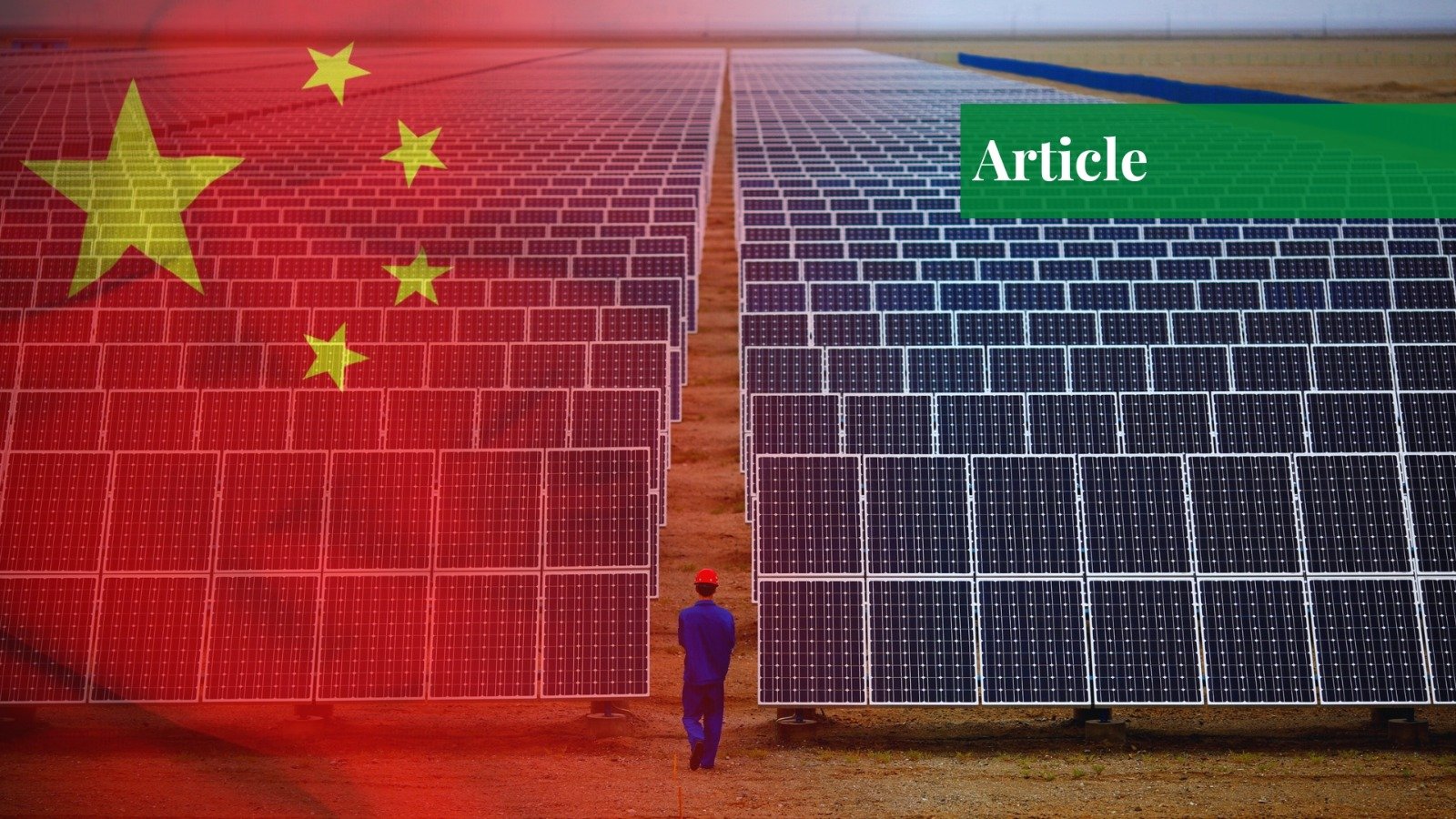Solar power has seen a fleet expansion in China under desert projects and the Qinghai Plateau as the plans are transformed into plight. This may sound far-fetched, but it is China’s reality: A bold ride into solar power. The world’s power in solar manufacturing and multifaceted installation is China, reducing the expenditure and increasing the momentum of moving toward cleaner power. The increase is, however, marred by hitches such as geopolitical tensions, as well as the fact that they still heavily rely on coal. In the following article, we will look at how China managed to emerge as a solar superpower, the waves it is spreading across global supply chains, and what they are saying about the future of our planet. Introduced in easy language to those who are not so familiar with the subject, the story of innovation, challenge, and the rise of solar energy in China is presented below.
The Foundations of China’s Solar Power Supremacy
China’s dominance in solar power didn’t happen overnight; it’s the result of clever government strategies, enormous manufacturing muscle, and smart investments abroad. At the heart of it all are national policies that treat solar energy as a top priority. Through documents like the Five-Year Plans, the government offers generous subsidies—essentially financial boosts—to solar projects, along with guaranteed prices for the electricity they produce. Investors are attracted by these measures, which stimulate advancements in the development of solar panels that are more efficient and much cheaper to manufacture.
Then there’s manufacturing might: China operates solar panel manufacturing on a scale never before seen, through tech-savvy power plants, automated production, and material delivery channels. In this way, it can produce top-quality panels at the lowest prices, smashing reductions worldwide and encouraging more countries to adopt solar. Inside China, strong local demand keeps things moving, thus, ongoing improvement.
Adding to this is China’s outreach through projects like the Belt and Road Initiative (BRI), where it funds solar farms in places like Asia, Africa, and Europe. These efforts not only export Chinese tech but also build lasting partnerships, helping other nations meet their energy needs while boosting China’s influence in the renewable sector.
The figures themselves would tell an elevating story: In 2023, China added an impressive 217 gigawatts (GW) to its solar capacity GW terms, power output enough to power over 200 million households. This was more than half the world’s new solar additions and surpassed the total solar setup in the United States up to that point. By 2025, China’s total solar capacity will have soared past 1000 GW, with massive farms sprouting in sunny western regions like Xinjiang and the Tibetan Plateau, and even innovative setups on coastal flats and deserts. All these positions China as the undisputed leader, transforming its own energy mix and making renewables more accessible globally.
Ripples Through Global Solar Power Supply Chains
China has a real impact on how and where people will buy and sell solar technology, and that includes the part of the solar value chain it has thoroughly dominated, 80% of the total global production from key materials like polysilicon to finished panels, manufacturing solar energy so cheap that it speeds up their acceptance all around the world. Scale, government support, and some brilliant cost-cutting innovations can bring efficiency.
But all this dependence has begun to frighten some nations, particularly the US and Europe. In extreme cases, relying on one country’s supplies for crucial technology could provide vulnerability in conflict or trade spats. Reports of hidden devices in some of the Chinese solar equipment, for instance, have raised the alarm about the potential to tamper with power grids.
There is also the human rights aspect. The Uyghur Forced Labour Prevention Act of the US has been active since 2022, which prohibits the entry of imports associated with potential forced labour in Xinjiang, a region known for polysilicon. This has led to the detention of solar shipments worth millions at US borders, therefore slowing down America’s green energy rollout, since it relies heavily on China’s supply for solar energy. The EU has similar worries and is imposing tariffs to safeguard local makers, in addition to thinking about bans on forced labour materials entering the region.
As a reaction, countries are diversifying. The US and the EU, among others, are investing heavily in homegrown manufacturing, although in the near term, not even close to matching the competitive pricing that characterises Chinese suppliers. It’s a balancing act: while China helps lower costs, it incites independence.
Geopolitical Shadows Cast by Solar Exports
With important decisions being taken at the international level that could influence and direct the course of clean energy into a possible monopoly or heaven in favour of China, solar exports are not simply a business. The BRI is seeing China send solar schemes abroad to developing regions and further cementing political and economic relationships in the process. So this could allow China to exert influence for its advancement in political and economic matters, allowing a country to be put into a position of reliance on Chinese financing and expertise.
With an 80% share of the market, China sets the agenda for worldwide discussions in clean energy, basking in the glory of climate savior. Solar deals in this place Middle East-are forging relationships in key energy hubs. But all this causes alarms to go off in the West since they feel encroached upon.
Thus, having collateral dependency on China could mean threats to regional stability and competition in the green energy field. The rise of solar in China is now changing the dynamics of power, with opportunities combined with rivalry.
Juggling Solar Energy Boom and Coal Reliance
From the soaring solar story, the confusion of the energy picture for the years 2024 and 2025 emerges, as China continues to grapple with its coal habit. In 2024, with solar capacity exceeding 880 GW, this year alone saw 277 GW added, which was double that of the total in the US by mid-2025. Another 212 GW joined, allowing wind and solar, together, to surpass coal in capacity for the first time and account for one-quarter of electricity generation in China.
Yet coal remains the dominant fuel for reliability. In 2024, China granted approvals to 66.7 GW of new coal plants and started construction on 94.5 GW, the highest level in a decade. Still, coal satisfies nearly 60% of energy demand, with consumption up 1% this year, notwithstanding solar gains, and is used in industries beyond power. Imports were at a record high due to cheap global prices.
That duality has come from energy security considerations, but it will hinder climate objectives such as peaking emissions in 2030. Experts propose to stop new coal plants and change markets to favor renewables. China’s trajectory shows the tension between green ambition and practical reality.
Counter-Moves from India, the EU, and the US
The other powers are not standing idle. India, under its schemes “Make in India,” is in a full swing to accelerate solar production, aiming at a hundred-gigawatt manufacturing capacity by the year 2025—up from 2.3 GW in 2014. Incentives aim for 500-gigawatt non-fossil energy by 2030, with an addition of 7.8 GW in early 2025, almost reaching a total installation of 90 GW. However, with imports from China still flowing, the increasing domestic capacity will help reduce dependence.
While the EU puts tariffs on Chinese panels from June 2025 and mandates a local production share by 2026, the solar industry would probably add up to about 83 GW a year by 2028, while 2025 would see an offset in gains versus keeping prices low.
The Inflation Reduction Act of the US is pouring in $369 billion for clean energy while adding 10.8 GW of solar in Q1 of 2025. Recent changes to incentives may speak to some controversies, but they propel manufacturing and jobs. These actions show a global response effort to secure the supply chain against the tide of China’s preeminence.
Stakes for the Planet’s Climate Ambitions
This solar boom in China may present a turning point in the fight against climate change by turning sunlight into a less costly and more popular alternative to fossils. This aids in cutting down emissions in the world, especially in less developed nations.
However, in the face of massive coal consumption, it is shadowy: Its continued use offsets gains made, making it more complicated for China’s 2030 and 2060 targets while also making decarbonisation more difficult and sluggish for the world.
The risk of supply chain disruption from over-dependence on China demands diversification for resilience. India, the EU, and the US are stepping up, which is exactly what we need for a robust transition.
In the end, China’s surge presents a golden opportunity for climate pain, but it will depend on fossil phase-out and the establishment of diversified supply chains thereafter. The next decades will either define whether the rise in China will ensure a sustainable world or it will increase energy inequalities in the world.
If you want to submit your articles and/or research papers, please visit the Submissions page.
To stay updated with the latest jobs, CSS news, internships, scholarships, and current affairs articles, join our Community Forum!
The views and opinions expressed in this article/paper are the author’s own and do not necessarily reflect the editorial position of Paradigm Shift.
Syed Salman Mehdi is a seasoned freelance writer and investigative journalist with a strong foundation in IT and software technology. Renowned for his in-depth explorations of governance, regional conflicts, and socio-political transformations, he focuses on South Asia and the Middle East. Salman’s rigorous research and unflinching analysis have earned him bylines in esteemed international platforms such as Global Voices, CounterPunch, Dissident Voice, Tolerance Canada, and Paradigm Shift. Blending technical expertise with a relentless pursuit of truth, he brings a sharp, critical perspective to today’s most pressing geopolitical narratives.



